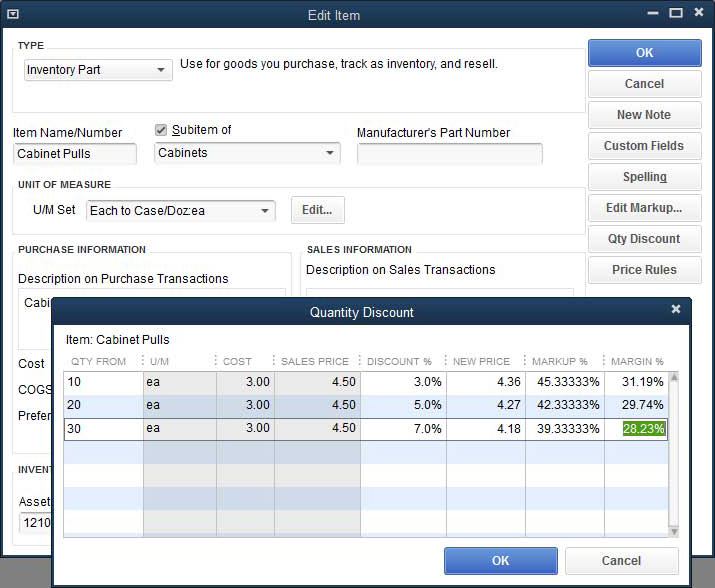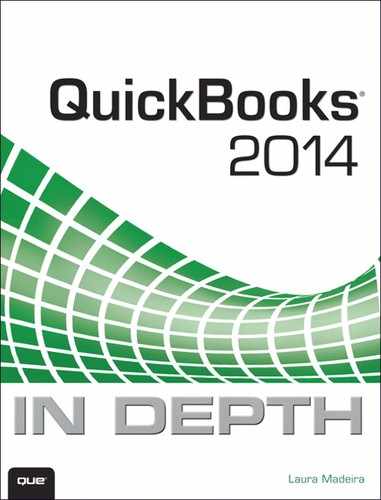What’s New in QuickBooks 2014
QuickBooks is both easy to learn and use. With improvements made in QuickBooks 2014, small businesses can complete their financial and accounting responsibilities with a minimum amount of effort so they can focus on growing their business.
All features detailed in this section are available in QuickBooks Pro, Premier, Accountant, and Enterprise versions unless otherwise stated.
New and Improved Features
The newest version of QuickBooks is designed help the small business save time managing their finances. For year 2014, users will find many requested improvements that will make tracking your business financials more efficient than ever.
Bounced Checks
Bounced Checks efficiently records the credit of funds to the bank account and marks the original invoice as unpaid when a deposited payment is returned due to Insufficient Funds (NSF). Optionally, it creates a credit to the bank for the NSF fee and a new invoice to the customer for any NSF fee charged.
→ To learn more about recording this type of transaction, see “Recording a Customer’s Bounced Check,” p. xxx.
Figure 1. Easily record bounced check transactions

Income Tracker
With Income Tracker, you can view customer transactions all on one screen. Get a summary of unbilled, unpaid and recently paid transactions on the Money Bar. Use the Money Bar to filter which transactions you see. Use the drop-down lists to filter transactions for ease in working activities in batch. Take immediate action on customer transactions in order to get them paid on time. You can efficiently work in a batch when working with transactions: create new, print, or email in batch. All data in the tracker is real time so the information is right at your fingertips. It is not necessary to prepare reports to see what actions need to be pursued to get paid.
→ To learn more, see “Income Tracker,” p. xxx.
Figure 2. Use the Income Tracker to track your customer transactions.
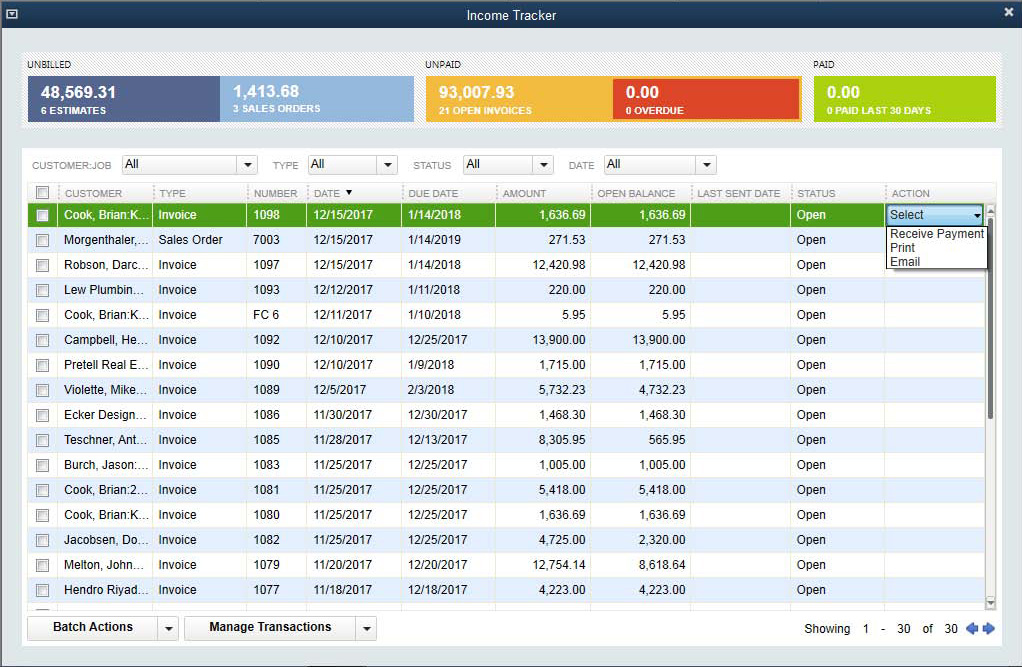
Inventory Min and Max Reorder Points
QuickBooks now provides both a Min and Max field for suggested reorder points. Prior versions of QuickBooks included a single reorder point field. Both Min and Max data displays on stock status reports. Additionally, in QuickBooks Enterprise, this new functionality permits QuickBooks to suggest a reorder point to reach the Max level when using Auto Create Purchase Orders.
→ To learn more about how QuickBooks uses these new re-order point fields, see “Auto Create Purchase Orders,” p. xxx.
Figure 3. QuickBooks provides Min and Max Inventory Reorder Points
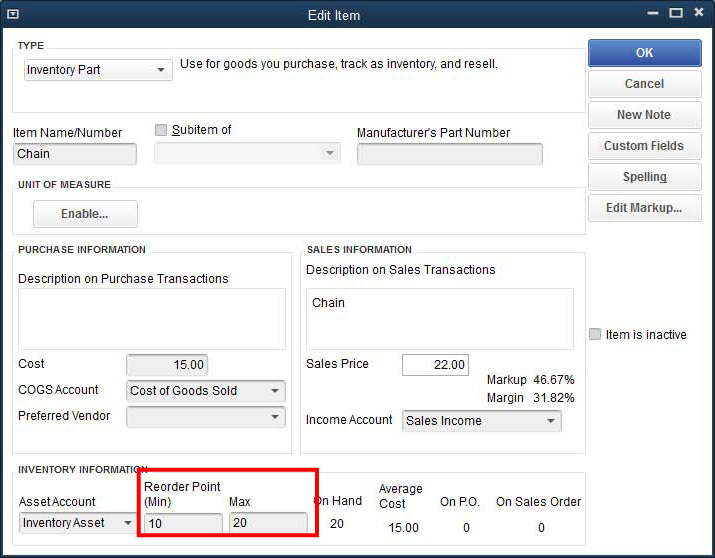
Sent Email Tracking
The Customer Center, Vendor Center and Employee Center all include a new tab that keeps a list of previously sent emails.
Figure 4. Track emails sent for Vendors, Customers, and Employees

Alerts and Reminders List on Menu Bar
New icons on the Menu Bar provide easy access to data performance alerts and company file reminders.
Figure 5. Alerts help you keep your software running efficiently

Bill Payment Stub Now Includes Bill Credits
When paying a vendor bill in full with a vendor credit, these paid bills and their associated credit are included on Bill Payment Stubs. If the only transactions are the vendor bill and the bill credit, and they are of equal amounts, QuickBooks creates a net -0- amount check in the checkbook register.
Figure 6. Paying a vendor bill with a vendor credit
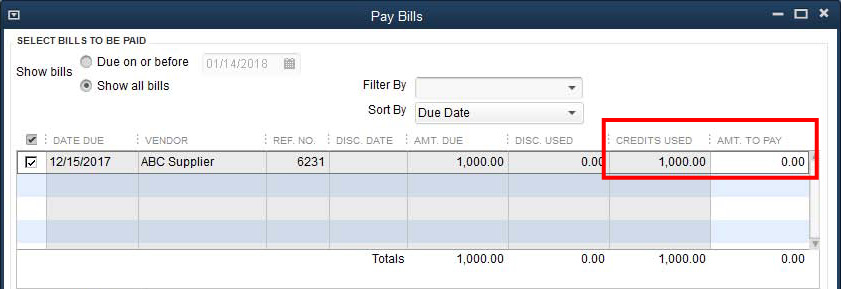
Figure 7. Bill payment stub now includes both the vendor bill and vendor credit
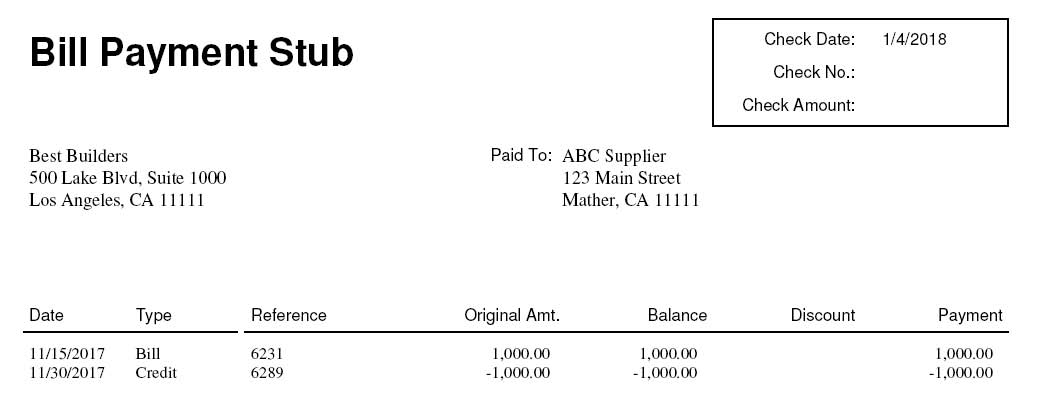
→ To learn more about this improvement see the Tip on p. xxx in Chapter 7, “Setting Up Vendors”.
Assign Sales Rep to Job Record
A Sales Rep can now be assigned uniquely to each job. In previous versions of QuickBooks, the Sales Rep could only be assigned to the Customer record and not the Job record. Additionally, you can filter many job profitability reports by Sales Rep.
Figure 8. Sales Reps can now be assigned to Job records in addition to Customer records

→ To learn more about adding a Sales Rep see, “Creating a Customer and Job Record”, p. xxx.
Job Status Reporting
QuickBooks users can now filter Job Profitability Reports (and others) by Job Status, a field that is assigned to Customer and Job records.
Figure 9. Filter reports by Job Status
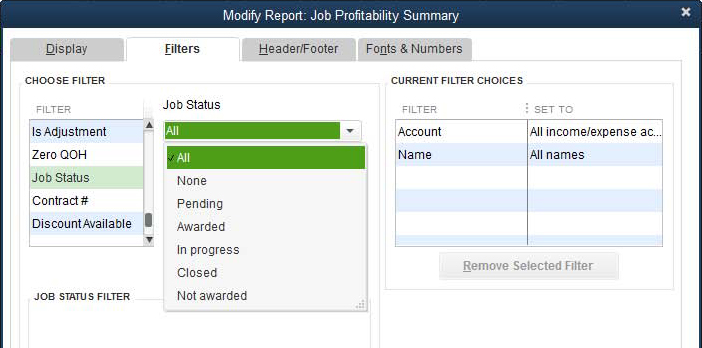
→ To learn about adding the Job Status to a customer or job record see, “Creating a Customer and Job Record”, p. xxx.
Left Icon Bar Customization
Previously all bank, credit card, Accounts Receivable and Accounts Payable accounts were displayed. This feature gives you the flexibility to display only the accounts you want to view on the Left Icon Bar.
→ To learn more, see “Left Icon Bar,” p. xxx.
Figure 10. Customize the accounts that display on the Left Icon Bar
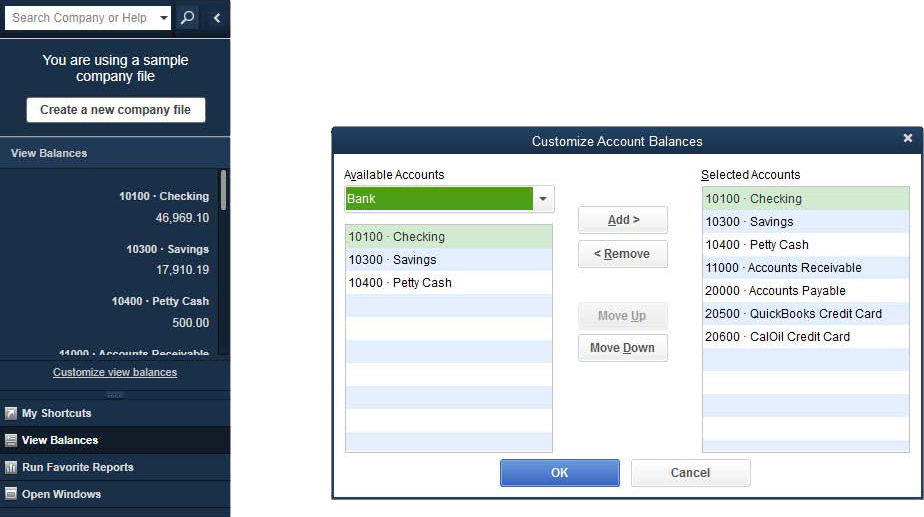
Color Customization Options
QuickBooks individual users can choose to switch to colored icons or a light background on the Top Icon Bar. It also permits the individual user to choose a color scheme for the data file. This is particularly useful when working with multiple QuickBooks data files.
→ To learn more about this and other preferences, see “Desktop View—My Preferences,” p. xxx.
Figure 11. Choose a Company File Color Scheme and other customizing options
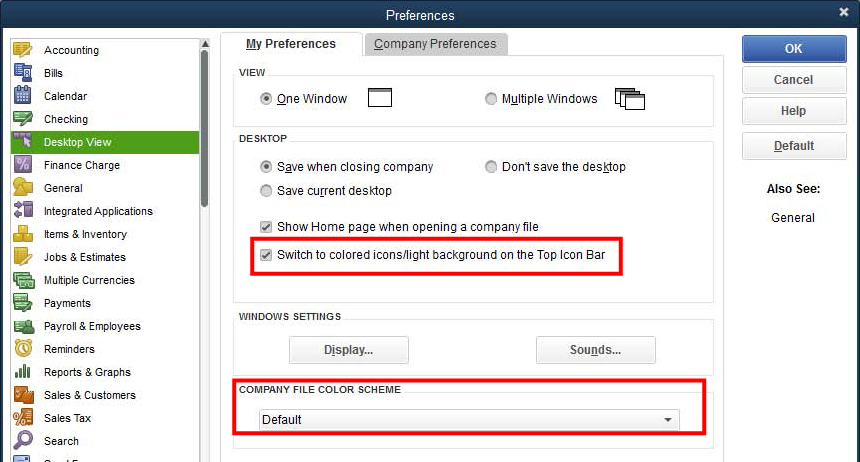
Bank Feeds
Bank Feeds is a feature that provides more efficient recordings of transactions downloaded from your bank or credit card provider. With improved Renaming Rules, each successive download of QuickBooks Bank Feeds remembers the details you have previously assigned to similar transactions.
→ To learn more, see “Bank Feeds,” p. xxx.
Figure 12. Download credit card and bank transactions using Bank Feeds
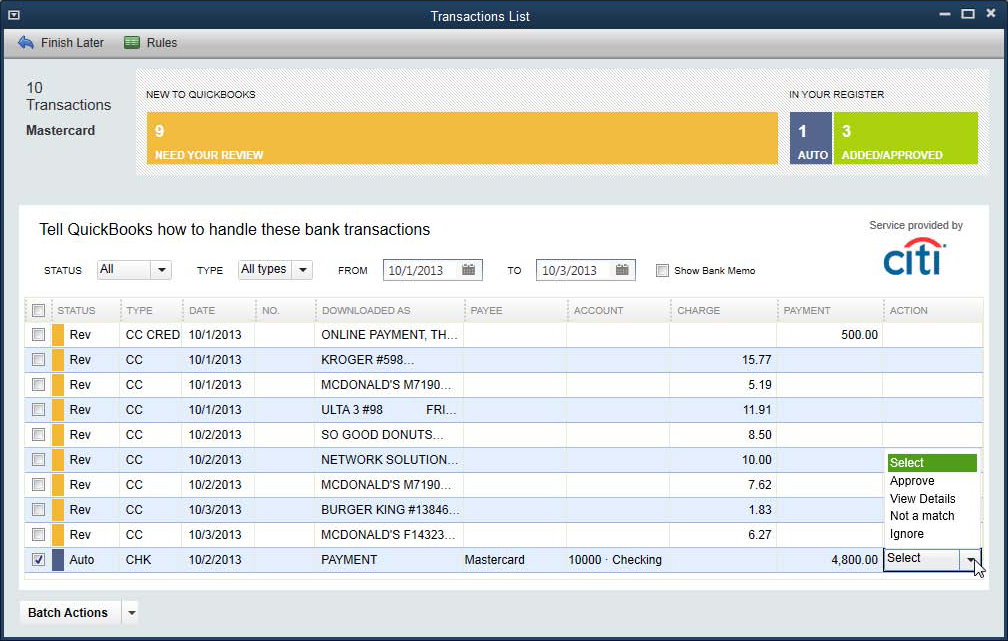
Sort and Resize Billable Time and Costs Window
The Choose Billable Time and Costs window can be resized and each column of data can now be sorted. This allows greater flexibility in how the data is displayed on a customer invoice.
→ To learn more about this type of invoicing, see “Time and Expense Invoicing,” p. xxx.
Figure 13. The sorted order is what will display on the customer’s invoice
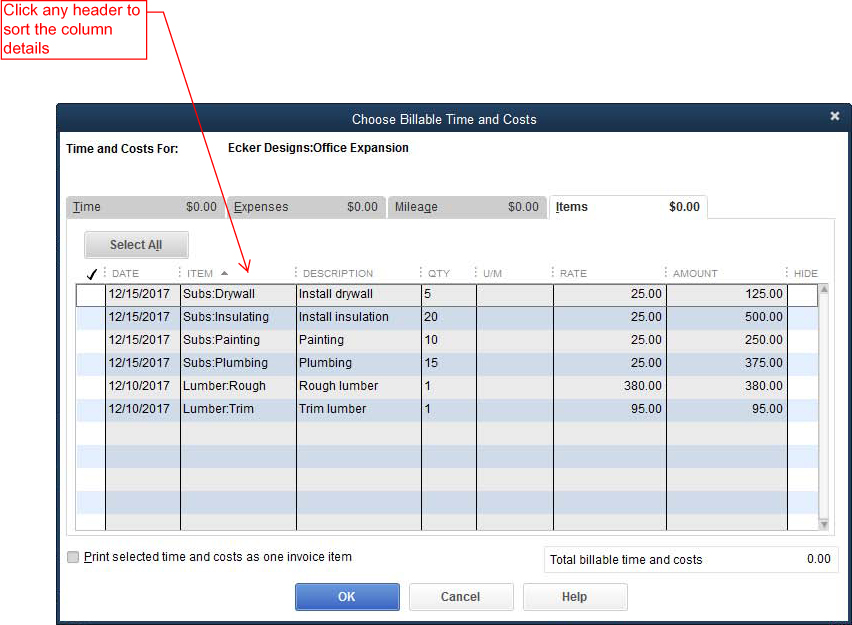
Create Multiple Email Templates
Customizable email templates let you auto-populate QuickBooks data such as invoice number and amount due in the body of the email, helping to ensure accurate communication.
Figure 14. Create custom email templates when communicating with customers, vendors, employees

→ To learn more about creating email templates, see “Preferences That Affect Accounts Receivable,” p. xxx
Include Attachments with Email
You can attach documents to transactions when emailing the transaction from within QuickBooks.
Figure 15. Add attachments to emails created in QuickBooks
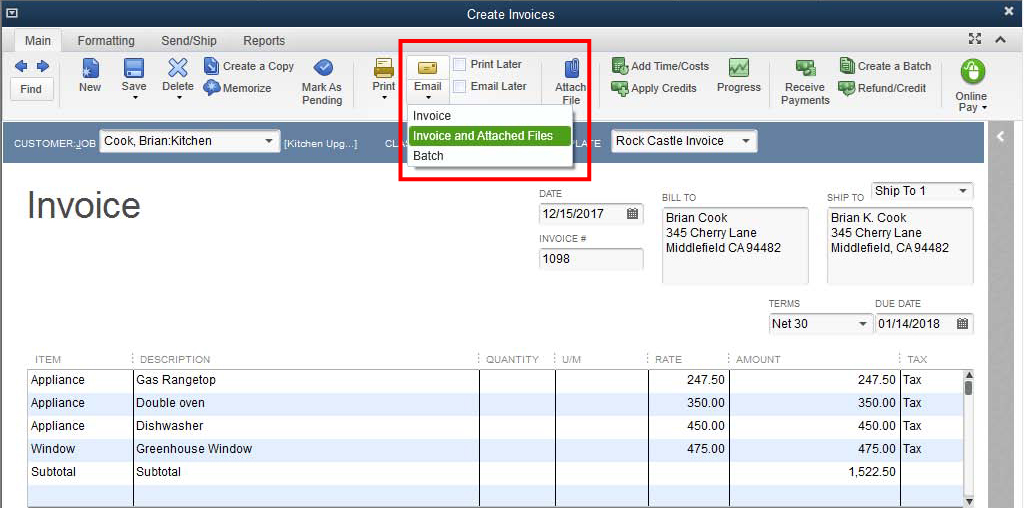
Figure 16. Browse, scan, or select from existing attachments

→ To learn more about adding attachments, see “Creating an Invoice,” p. xxx.
More Reports on Transaction Ribbon
Work more efficiently with access to more transaction specific reports accessible from the ribbon toolbar on displayed transactions.
Figure 17. Reports tab on ribbon toolbar offer a variety of transaction specific reports
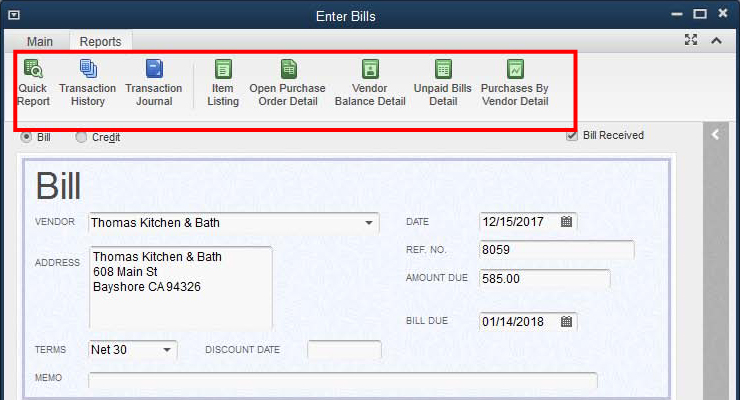
Print to One Page
When printing a report, users can choose to fit the printed report to a specified number of pages(s) wide and a specified number of pages(s) high.
Figure 18. Option now to determine both the width and height of a report
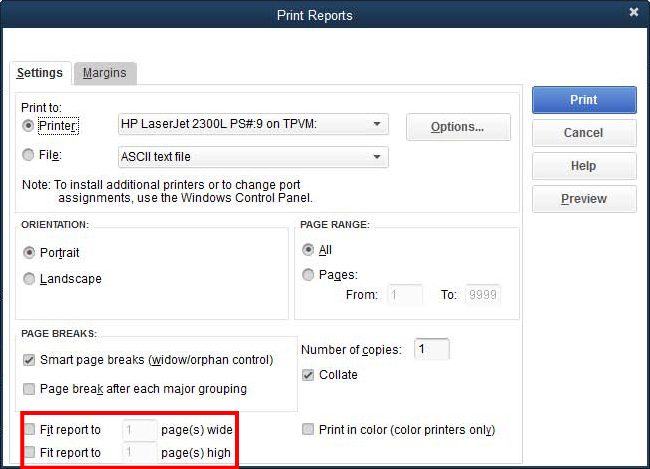
Copy and Paste Line Items on Forms
Copy and paste transaction line data to another line in customer forms and purchase forms with the formatting tab on the transaction ribbon toolbar.
Figure 19. Right-click with your cursor on a line or access from the ribbon toolbar
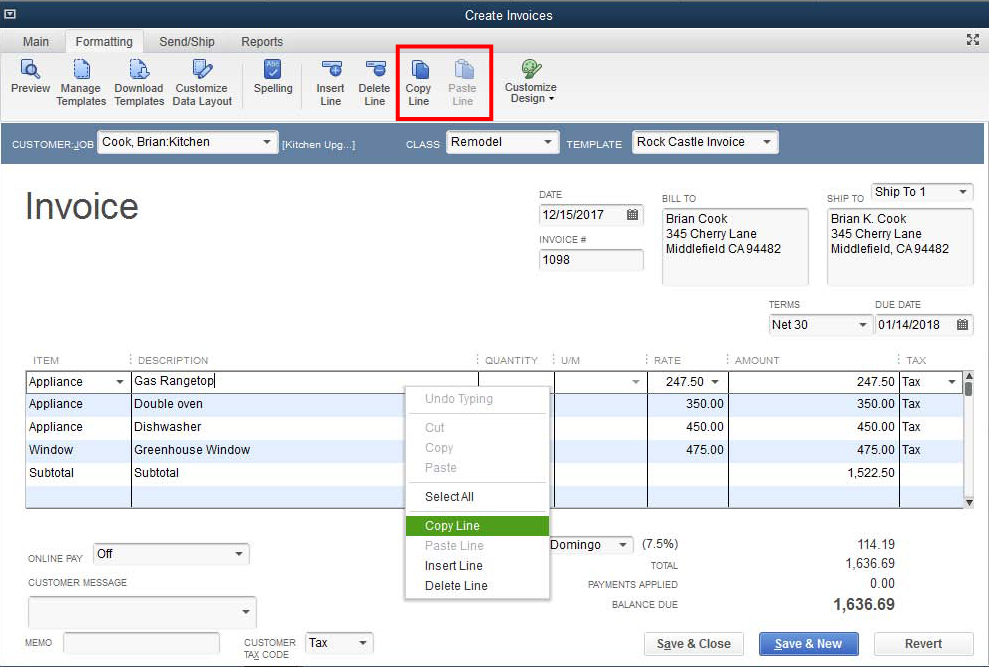
→ To learn more about copying and pasting rows of data on invoices, see “Creating Customer Invoices,” p. xxx.
Improved Payroll Center
The new user interface available in the Payroll Center separates the details for payroll into three important groupings: Pay Employees; Pay Liabilities, and File Forms.
→ To learn more about working with the Payroll Center, see “Preparing Payroll Liability Payments,” p. xxx and “Tax Forms and Filings,” p. xxx.
Figure 20. New Payroll Center tabs makes processing and reporting on payroll tasks more efficient
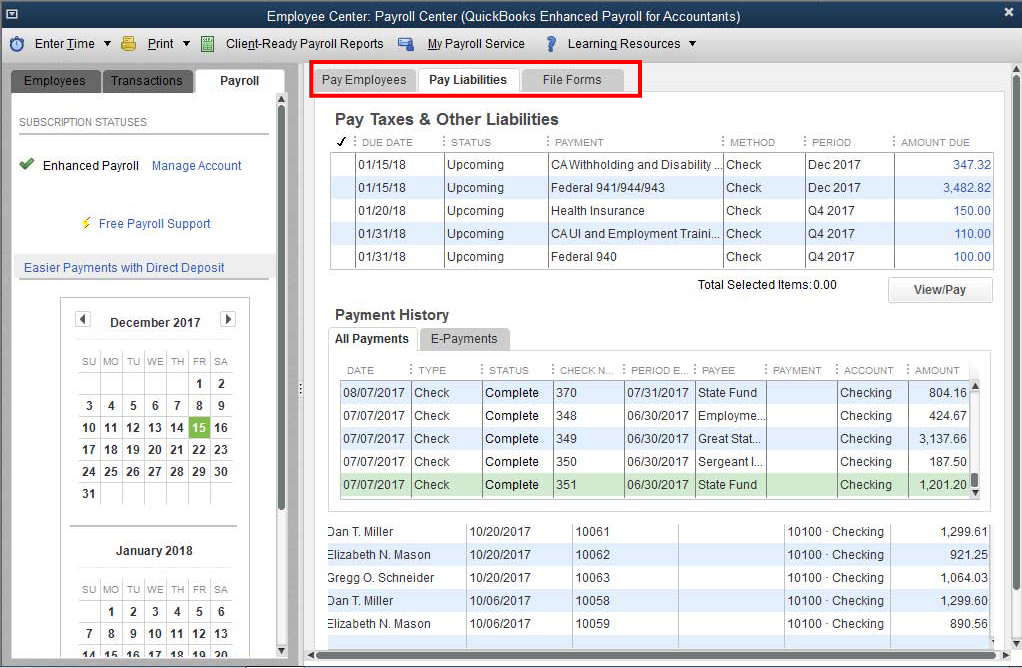
Improved My Company Information
The new My Company information window replaces the formerly titled Company Information window. In addition to listing your company’s address, Federal Identification Number, and other items, the window now displays your connected apps, services and subscriptions. From this window you can also view suggested apps, services and subscriptions as well as log into your Intuit Account.
Figure 21. Easy access to subscribed applications others recommended in the new My Company window
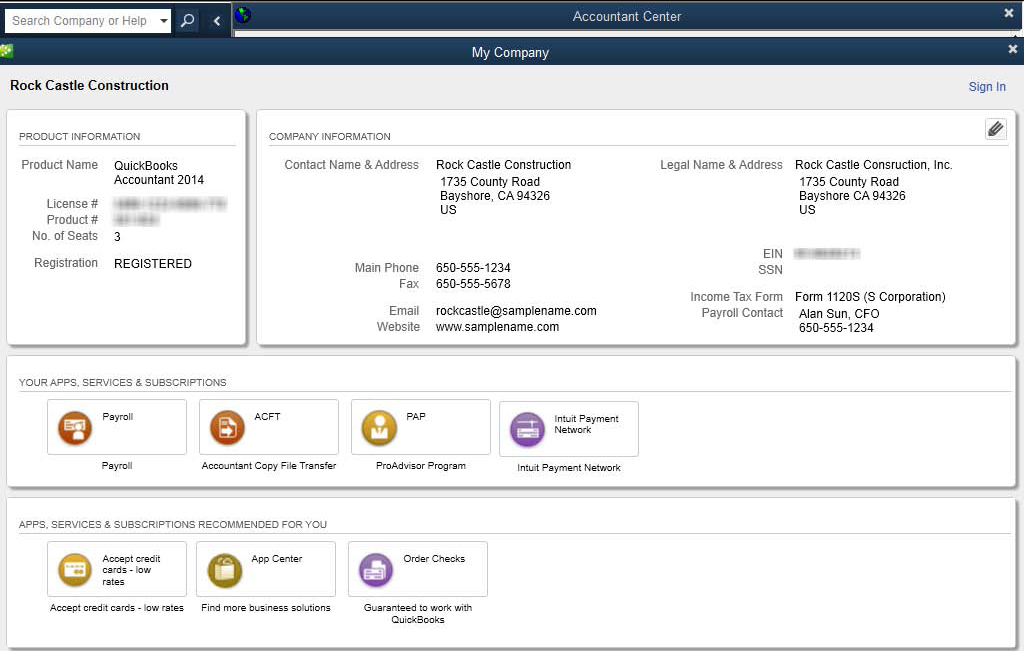
→ To learn more, see “My Company Information,” p. xxx.
Enable or Disable Collection Center
Company preference to re-enable the Collection Center, the functionality was replaced with the Income Tracker (see previous topic). For those users that prefer to work with the Collections Center in addition to the new Income Tracker.
→ To learn more, see “Enable the Collections Center,” p. xxx.
Figure 22. Option to enable the Collections Center for those that want to continue using it in addition to the Income Tracker
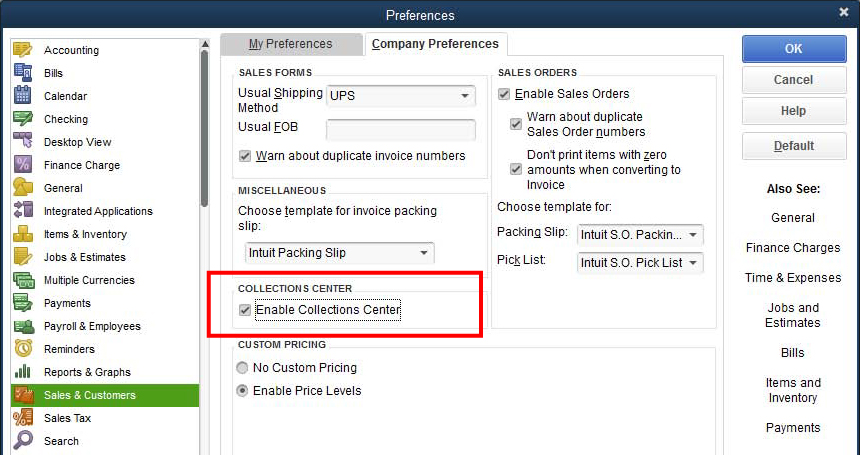
Figure 23. After enabling the Collections Center, access it from the Customer Center
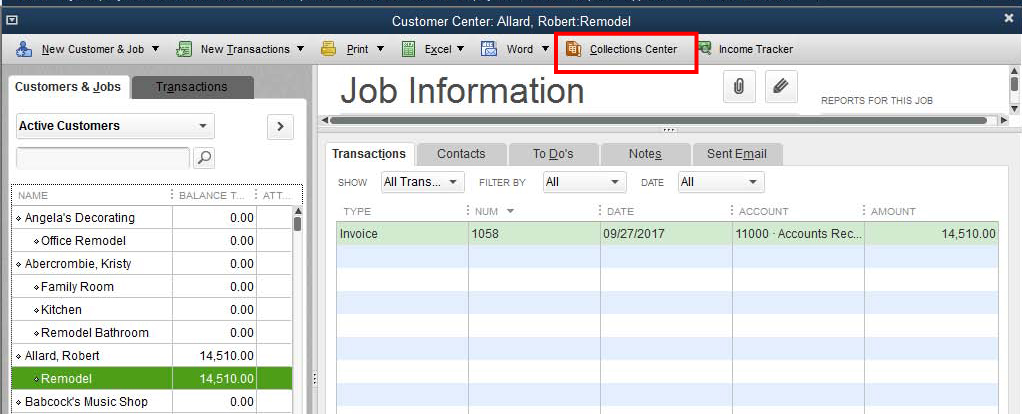
For the Accounting Professional
QuickBooks Accountant 2014 and Enterprise Accountant 14.0 add even more tools and improvements to empower you to work more efficiently with your clients’ data.
Client Collaborator
Client Collaborator is available exclusively with QuickBooks Accountant 2014 PLUS, free for ProAdvisors with paid membership or available for an additional fee. This feature is available with QuickBooks Enterprise Solutions Accountant with a paid Full Service Plan. The software stores online inquiries about specific transactions. The client needs only to use QuickBooks 2014 desktop software, and be invited by the accountant to access the transaction inquiry and provide replies.
→ To learn more, see “Client and Accountant Collaboration,” p. xxx.
Figure 24. Accountants can associate questions with specific transactions for the client to reply to

Improved Batch Enter Transactions
In addition to batch entering Checks, Credit Card Charges and Credits, you can now also enter Vendor Bills and Credits and Customer Invoices and Credit Memos in a spreadsheet-like interface. Alternatively, copy and paste 1000+ transactions from a spreadsheet and save them at once in QuickBooks.
→ To learn more, see “Batch Enter Transactions,” p. xxx.
Figure 25. Bills, Bill Credits, Invoices and Credit Memos now can be entered in batch

Improved Client Data Review
Reclassify Transactions now permits reclassifying the “Source or From” account including Balance Sheet accounts. The change can only be between accounts of the same type, such as between one Bank account and another Bank account, etc.
→ For accounting professionals who want to learn more, see “Client Data Review,” p. xxx.
Figure 26. Improved reclassify the “From Source” between same type Balance Sheet accounts
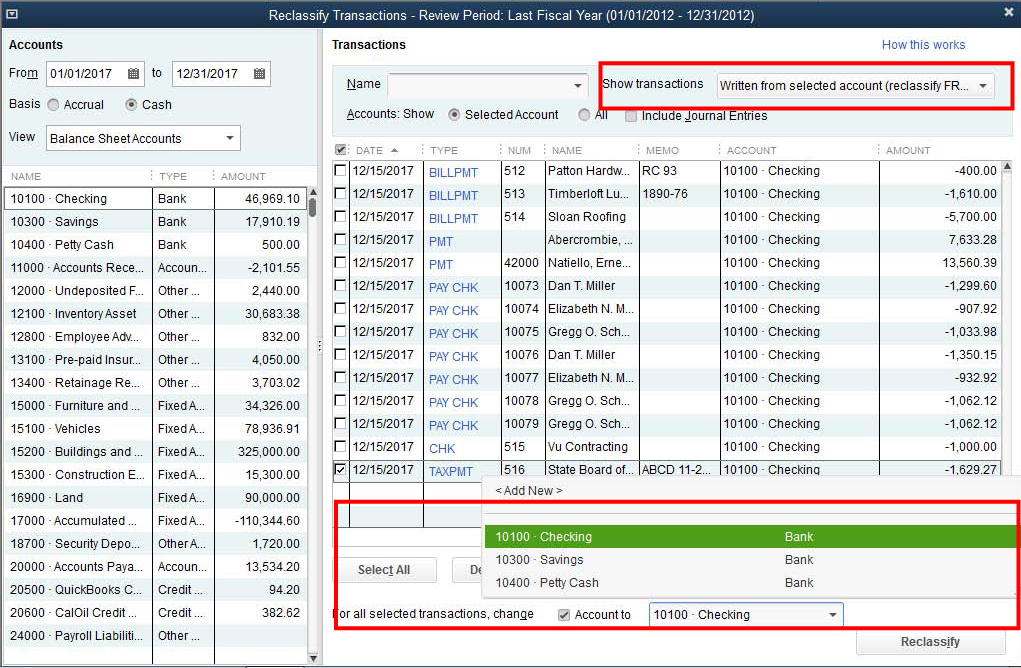
For QuickBooks Enterprise Users
QuickBooks Enterprise users often push the limits of software because of their transaction volume, number of users, or other complexities. In that regard, QuickBooks Enterprise 14.0 builds on its slate of advanced features with these new additions for 2014.
Note
The remaining features discussed in this section are available only when using the QuickBooks Enterprise Software.
Add Sales Rep and Custom Fields to Expense Transactions
Users can optionally add Sales Rep and custom defined fields to the Write Check, Vendor Bill or Credit or Credit Card Charge or Credit transactions.
→ To learn more, see “Customize Expense Transactions,” p. xxx.
Figure 27. Add Sales Rep and/or your own custom fields to expense or items tab

Job Work in Process (WIP) Summary Report
This new report provides much needed details for any industry that needs to report revenue based on a percentage of completion computation for their jobs.
One industry in particular, the construction industry, uses this type of calculation to determine the amount of revenue to record in their financials as year-end.
→ To learn more about this report, see “Job Work in Process (WIP) Summary,” p. xxx.
Figure 28. New report used by industries that need to calculate over/under billings
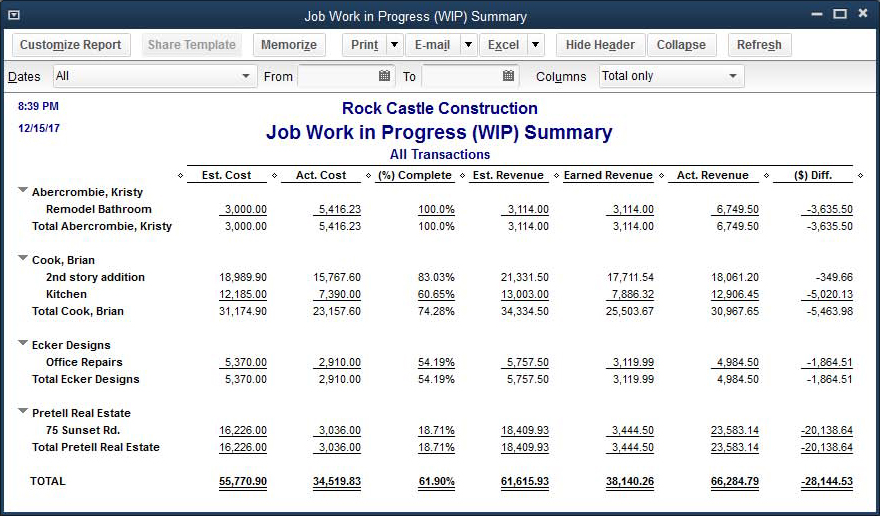
Committed Costs by Job Report
This report provides a more comprehensive view of a Customer or Job potential profit or loss. The report includes: Estimated Costs less Actual Costs less Committed Costs (open $ value on purchase orders) less Unpaid wages to arrive at Remaining Cost.
→ To learn more about this report, see “Committed Cost by Job Report,” p. xxx.
Figure 29. Report includes open balance on purchase orders and timesheet payroll estimate
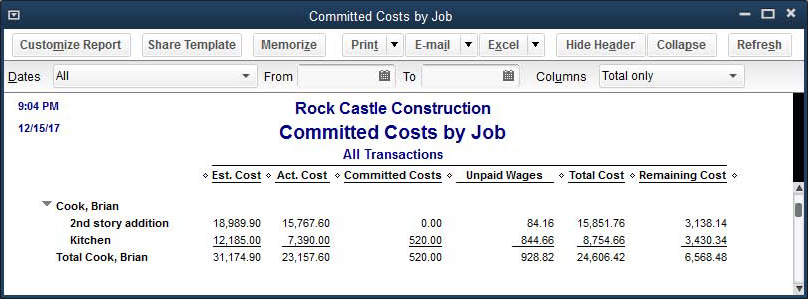
Automatically Build Subassemblies
For some industries, inventory assemblies may have subassemblies as components. In order to complete the final assembly, QuickBooks has to have on hand the required quantity of the subassemblies. QuickBooks Enterprise improves the process of working with assemblies by allowing users to first have QuickBooks build the subassemblies. In QuickBooks Premier, the other edition of QuickBooks that offers assemblies, users have to know to build the subassemblies first.
→ To learn more about working with subassemblies, see “Automatically Build Subassemblies,” p. xxx.
Figure 30. Optionally select when building assemblies with “nested” assemblies
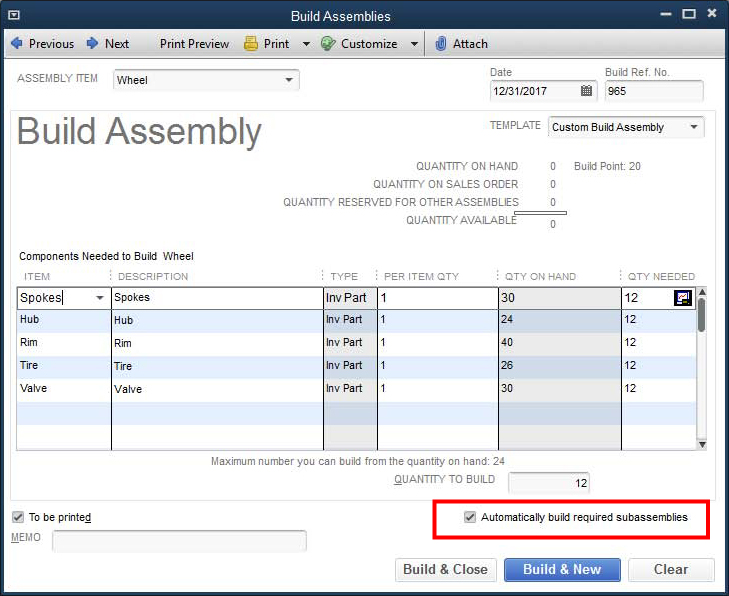
Efficiently Replace or Remove Components in Assemblies
QuickBooks Enterprise improves the process of adding or removing components in an assembly. Only in QuickBooks Enterprise can users choose to automatically remove or replace components in multiple assemblies easily. In QuickBooks Premier, if a component is used in multiple assemblies and needs to be removed or replaced, users have to manually edit each assembly that includes that component.
→ To learn more about working with components of assemblies, see “Replace or Remove Components in Assemblies,” p. xxx.
Figure 31. Substitute a new component or remove an existing component from multiple assemblies
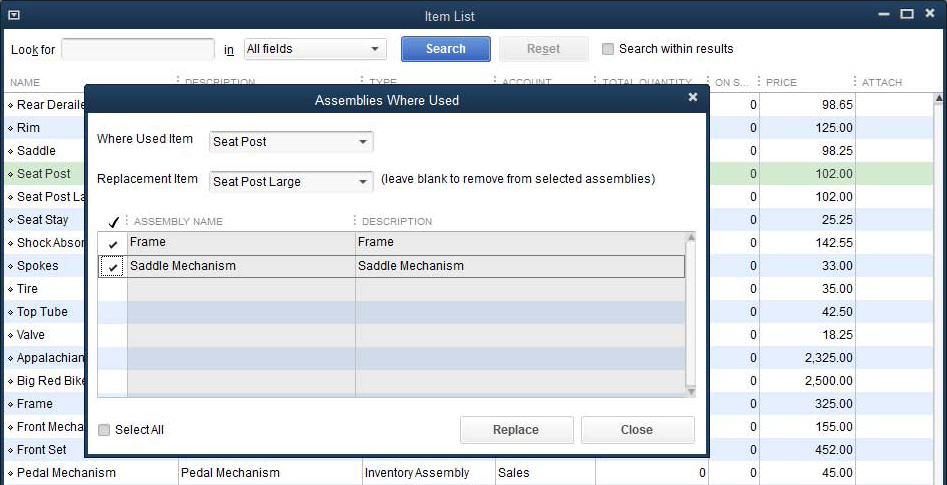
Options for Auto Calculating Cost Field in an Assembly Record
Another related assembly improvement included exclusively with QuickBooks Enterprise is the ability to set a default for handling the Cost field in an Assembly type item record.
→ To learn about this feature, see “Options for Auto Calculating Assembly Cost Field,” p. xxx.
Figure 32. Users can choose to have the Cost field automatically calculated
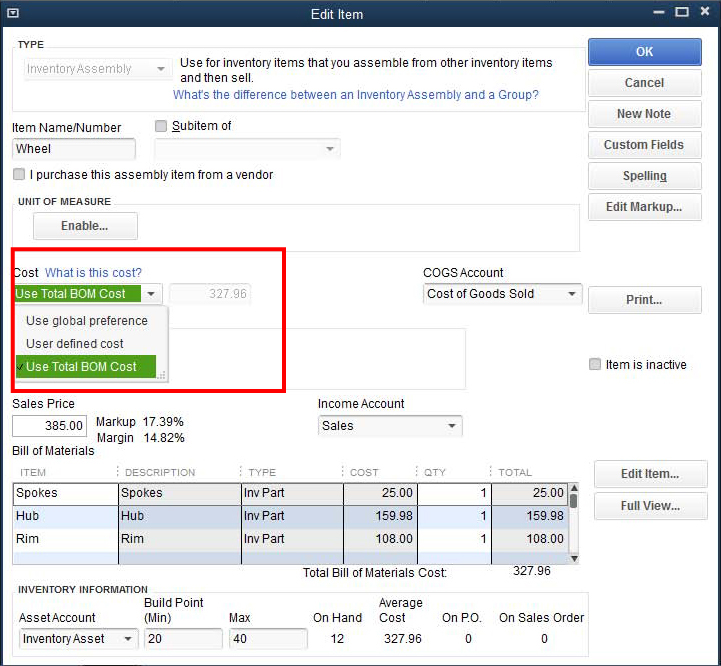
Efficiently Edit Cost, Price, Markup and Margin for Inventory Items
The Inventory Center is available in QuickBooks Premier, Accountant, and QuickBooks Enterprise Solutions. In QuickBooks Enterprise, the Inventory Center includes the ability to edit the cost, sales price, markup and margin without opening the individual item record.
→ To learn more, see “Inventory Center,” p. xxx.
Figure 33. Conveniently edit fields while viewing inventory details in the Inventory Center
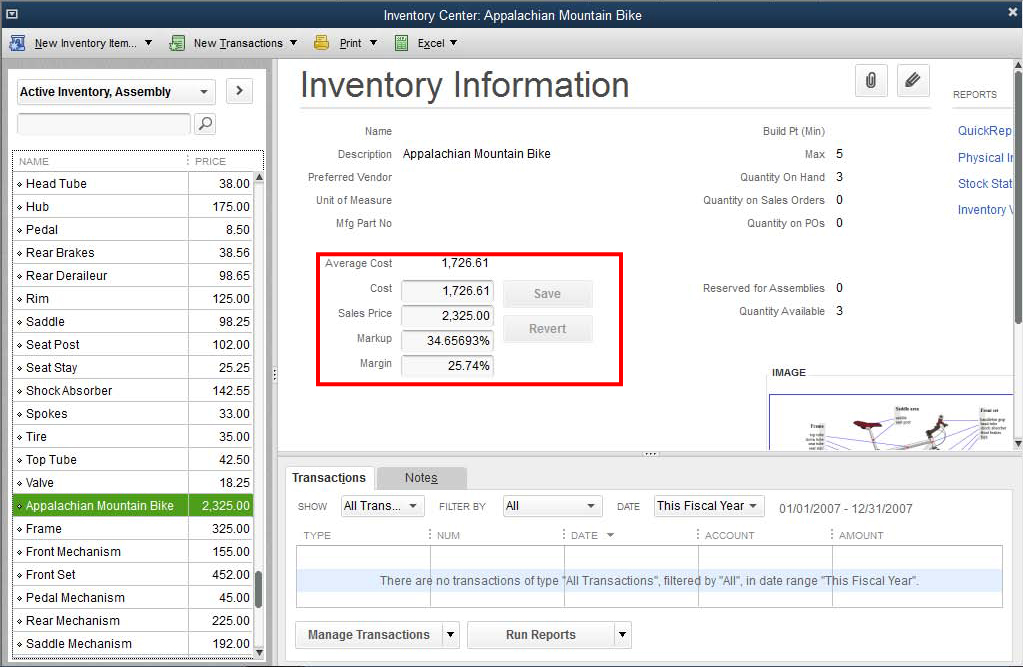
Create Auto POs Now Suggests Quantity to Order
The Auto Create Purchase Orders feature available exclusively in QuickBooks Enterprise will help you restock your items in record time. In prior versions of QuickBooks you would review your inventory reorder reports, and then create a single purchase order at a time.
New for QuickBooks Enterprise 14.0, the Auto Create Purchase Orders will now suggest a quantity to purchase. The suggested Quantity factors in the Quantity Available, Quantity on Purchase Orders and then compares this to the Reorder Point, Max value for the item.
→ To learn more about this feature, see “Auto Create Purchase Orders,” p. xxx.
Figure 34. Suggested Qty to Order will bring inventory up to Max reorder point

QuickBooks Enterprise with Advanced Pricing
Exclusively for QuickBooks Enterprise 14.0 is Advanced Pricing. Advanced Pricing is a subscription-based feature charged annually and also requires an active Full Service Plan. The feature replaces the free Price Levels with much more sophisticated automated price settings.
→ To learn more about this new feature, see “QuickBooks Enterprise with Advanced Pricing,” p. xxx.
Price Rules
Price Rules let you automate your pricing in QuickBooks. No more manual updates, easily change your sales prices. With multiple variables you can set prices for scheduled promotions with future start dates, change the price charged by class (i.e. location), extend a price change to certain customer or job types, and set a price to be exclusive of any other specials.
Figure 35. Create a variety of conditions to control the use of a Price Rule

Quantity Discounts
Also included with the Advanced Pricing subscription is Quantity Discounts. With Quantity Discounts, you can reward your customers for making bulk purchases.
For example, QuickBooks can charge different prices when a customer buys 10 to 19 items or 20 to 29 items or 30 or more items.
Figure 36. Advanced Pricing (Subscription) includes both Price Rules and Qty Discount
